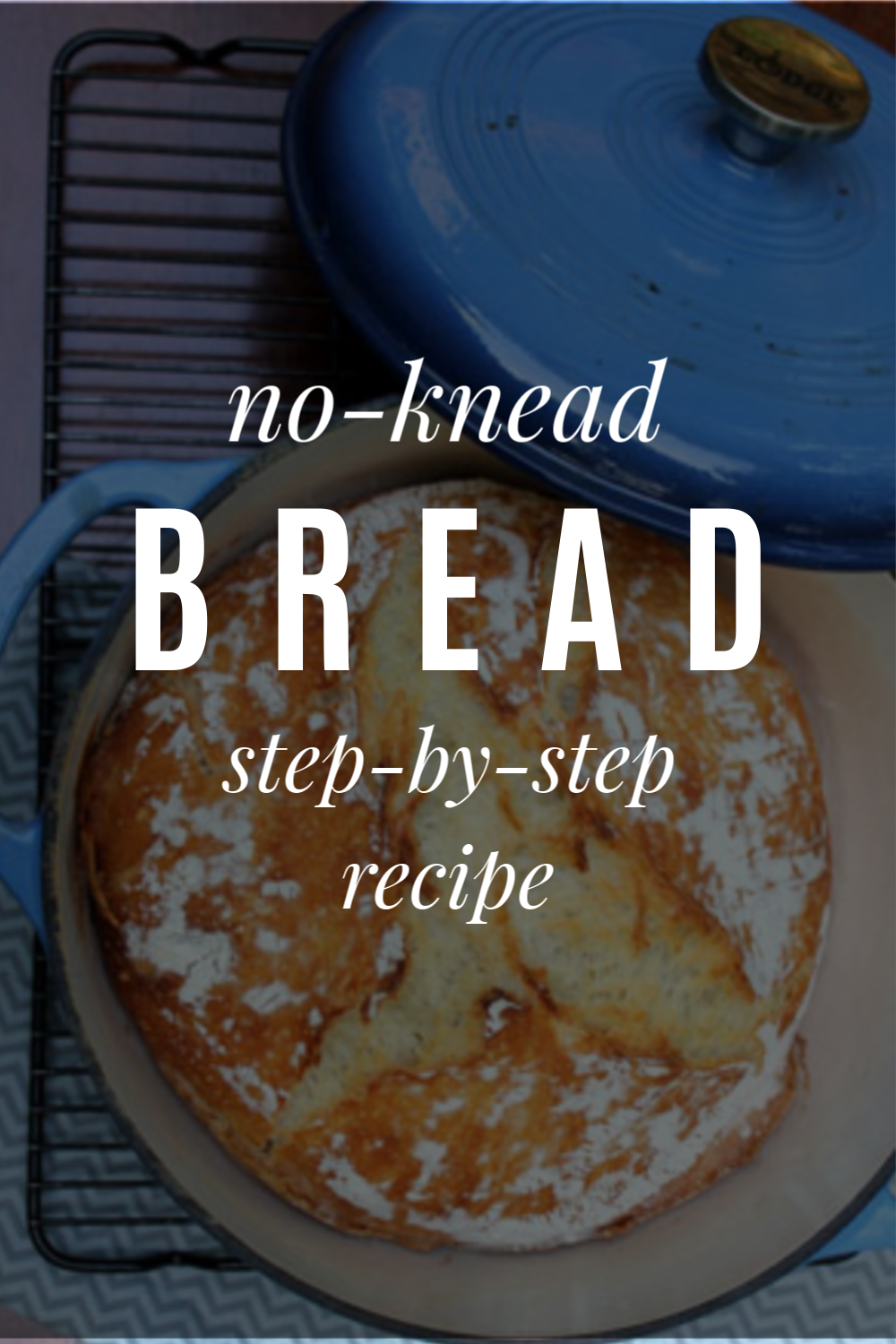
No-Knead Bread Recipe
If you have been hanging out around Frugal Living NW for awhile, you know that I am a big believer in making food from scratch at home. With a few exceptions, I prefer creating something in my own kitchen to buying it in the grocery store.
Bread can be tricky, though. There is some stiff competition out there, and it is tough to replicate a commercial oven’s heat and steam in a normal home kitchen.
For the last several years, I thought that Artisan Bread in 5 Minutes was the best thing since, well, sliced bread. It was simple, and we were content with the results. That is, until last summer when our neighbor brought over a beautiful, delicious loaf of home-baked bread. We had to know her secret. One phone call, and she came back with the book, My Bread by Jim Lahey (Amazon).
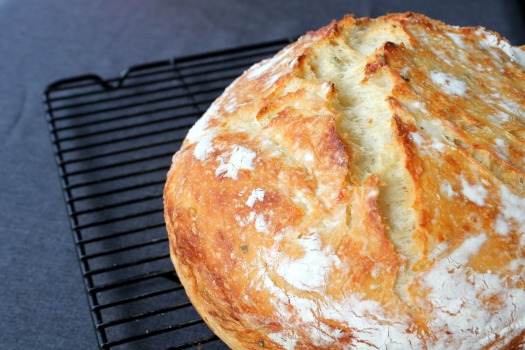
We have been baking bread using this method ever since. I can count on one hand the number of times I have bought bread in the store since then, because I can now make an artisan-quality loaf at home for a fraction of the cost.
I am telling you, this is consistently the best bread I have ever made in my kitchen. Okay, enough gushing. Let’s make some bread.
The only changes I have made to Lahey’s method is to double the amounts and adjust the baking time and temperature to achieve a bigger loaf with a thinner crust.
Oh, and don’t be put off by all these steps. This is totally possible for home bakers at any skill level. I wanted to give you the confidence to do this on your own. A concise recipe can be found at the bottom of this post.
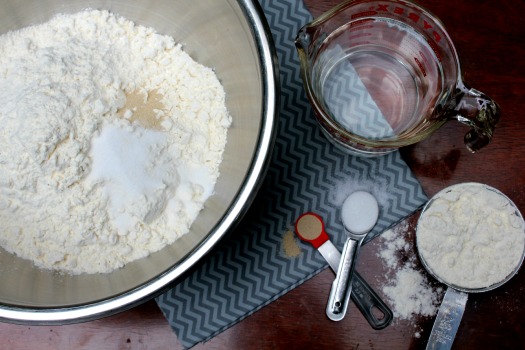
The ingredients are simple: flour, water, salt, and yeast. My husband calculated this bread costs 74¢ per loaf (using Bob’s Red Mill flour & Costco yeast).
Oh, wait! Don’t forget to factor in the roughly 8 cents of energy used to bake it for an hour. No, I’m serious. My husband really does think about this stuff! He’s funny.
So, there you go. A whopping 81¢ for a substantial 2.5 pound loaf of bread. That is crazy cheap.
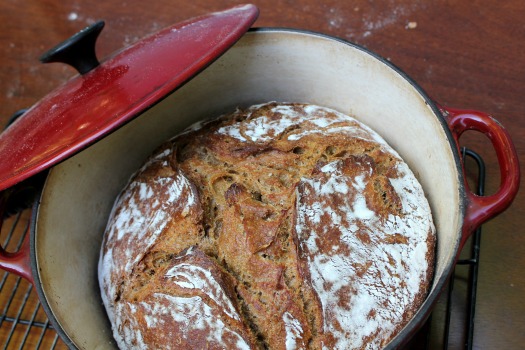
If you want to use some whole wheat flour, substitute 3 cups of whole wheat for 3 cups of the all-purpose flour (3 cups whole wheat and 3 cups of unbleached flour for a total of 6 cups) and add 3 Tablespoons of molasses (optional). This will produce a slightly sweeter, denser loaf of bread. Delicious.
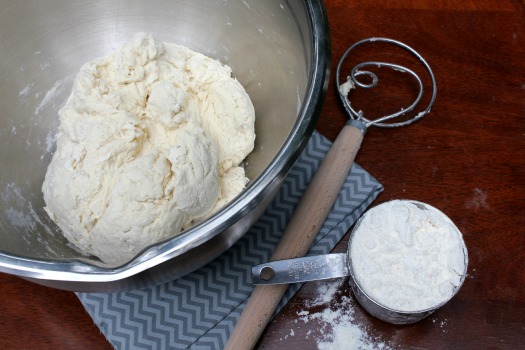
Combine the dry ingredients, add the water, and stir to combine (the funky looking wood-handled item is the amazing Danish Dough Wisk — makes stirring stiff dough a snap). The dough should be wet and sticky. Depending on the temperature and humidity in your home, you may need to add a little more flour or water, 1 Tablespoon at a time. So far, these steps are exactly the same as the 5 Minute method.
The main differences are that you use significantly less yeast (1/2 teaspoon vs. 1 1/2 Tablespoons) and significantly more initial rise time (12-18 hours vs. 2 hours).
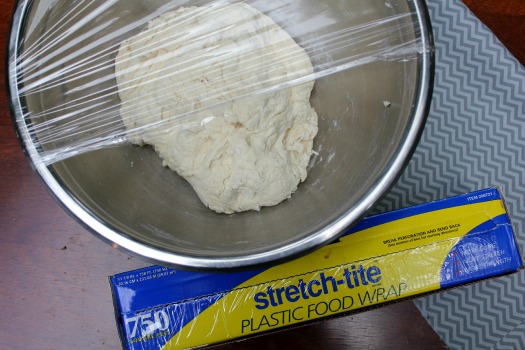
Once the ingredients are completely combined, cover the bowl with plastic wrap and leave it on the counter to rise for 12-18 hours. This slow rise aids in the fermentation of the yeast, giving the bread a better flavor.
Okay, I know what some of you are thinking: 12-18 hours! That’s ridiculous! Who has that kind of time?! I get it.
However, here are two things to consider:
- Once you get into a rhythm of baking your own bread, it’s not a big deal. I start mine in the afternoon or evening and bake it the next morning or afternoon. This would also be an easy weekend routine.
- Just like the title claims, this bread requires no kneading. It is not fussy, temperamental dough. You can produce a delicious loaf of bread with very little hands-on effort & experience.
You’ll know your dough is ready when it has risen in the bowl, smells yeasty, darkened slightly, and is covered with small bubbles.
Using well floured hands, shape and tuck the sticky dough into a rough ball. You can also fold it over a couple times on a well-floured surface. It doesn’t have to be perfect; just keep quickly tucking the dough underneath with your fingertips until you have a semi-smooth dough ball. The dough should be wet but manageable; you don’t want a wet blob so sticky that you can’t shape it into a ball.
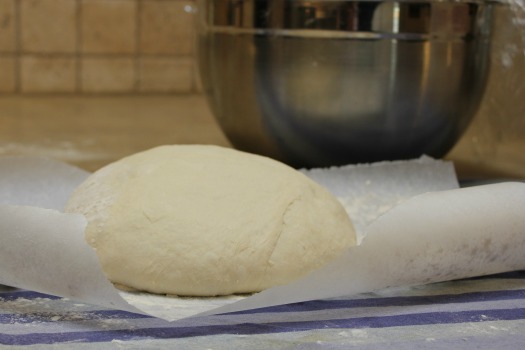
Take a clean linen or cotton tea towel (not terry cloth) and dust it with flour, cornmeal, or wheat germ to prevent the dough from sticking to the towel as it rises. You can also use a floured square of parchment paper on the towel to make the dough ball easier to handle. Place the dough ball, seam side down, in the middle and dust with more flour.
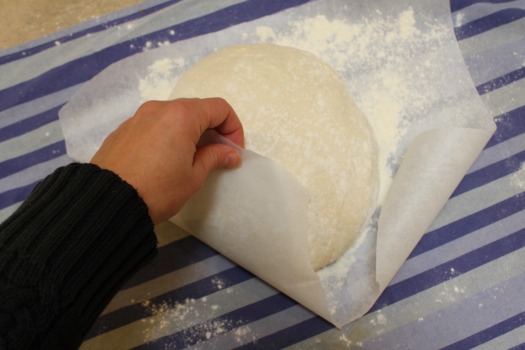
Cover the dough with the (parchment paper and) towel and let it rise for 1-2 hours at room temperature, until doubled in size. During the last 30 minutes of rise time, place a heavy lidded 6-8 quart pot, like a Dutch oven, in a cold oven and preheat it to 425 degrees.
Confession: I own three Dutch Ovens. I use them all the time. They are incredibly versatile and worth the investment. If you don’t own one, you could also make this in any lidded pot, provided it is oven-safe at such high temperatures. Also, check the knob on your pot. If it isn’t rated for such high heat, you’ll want to remove it or cover it with foil. You can also buy an inexpensive replacement knob that is rated for higher temps!
Okay, this is the trickiest part of the entire operation. Remove the lid from the piping hot Dutch Oven, slide your hand underneath the towel or parchment paper, and flip the risen dough (seam side up now) into the pot. Try to flip close to the pot or the flour will fly everywhere. Remove the towel or paper and set aside.
This might take a bit of practice, but again it doesn’t have to be perfect. Some of my worst flips have produced my most beautiful loaves. I love what Lahey writes, “…even the loaves that aren’t what you’d regard as perfect are way better than fine.”
Place the lid back on top and slide the pot back into the hot oven.
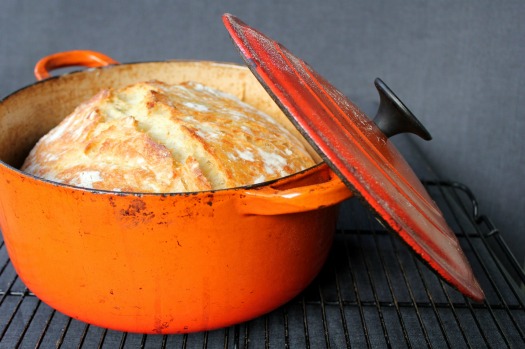
Bake it for 40-50 minutes. Remove the lid. Bake for another 5-10 minutes, until golden chestnut brown. The internal temperature should be around 200 degrees. You can check this with a meat thermometer if you’re nervous about knowing when your loaf is done.
Oh man, your house will smell so good about right now.
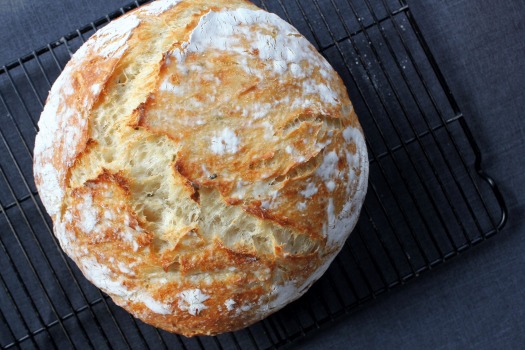
Place the loaf on a cooling rack. You will hear it crackling as it cools. Use every ounce of self-control to resist cutting into it until it is “quiet”; cutting it too soon will make the bread dense and gummy.
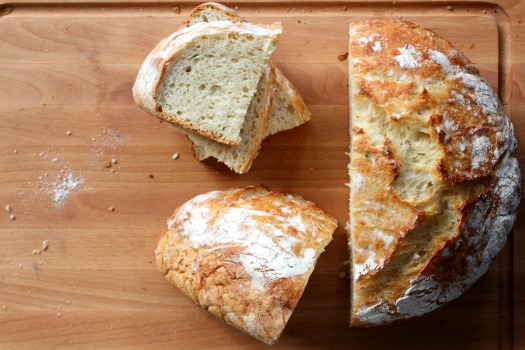
This bread is best the first 2-3 days. I just store my leftover loaf inside the Dutch oven on the countertop. Using plastic wrap will soften the crust. Dry, leftover bread makes great bread crumbs, toast, French toast, or croutons!
Enjoy. And pat yourself on the back. You just baked an amazing loaf of bread!
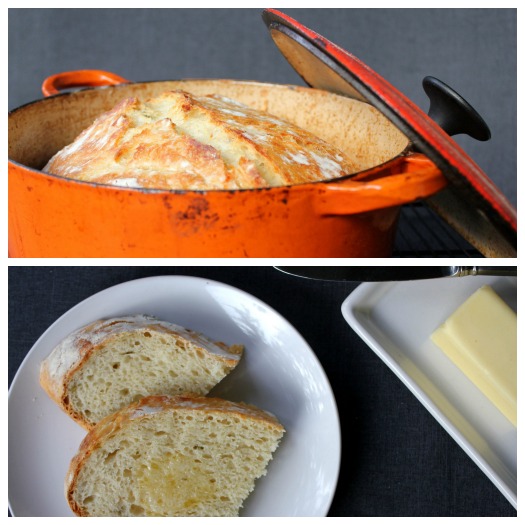
Basic No-Knead Bread
Slightly adapted from Jim Lahey’s My Bread
Ingredients
6 cups bread flour (recommended) or all-purpose flour, plus more for work surface
1/2 t. instant or active-dry yeast
2 1/2 t. salt
2 2/3 c. cool water
- In a large bowl, combine the flour, yeast, and salt. Add the water and stir until all the ingredients are well incorporated; the dough should be wet and sticky. Cover the bowl with plastic wrap. Let the dough rest 12-18 hours on the counter at room temperature. When surface of the risen dough has darkened slightly, smells yeasty, and is dotted with bubbles, it is ready.
- Lightly flour your hands and a work surface. Place dough on work surface and sprinkle with more flour. Fold the dough over on itself once or twice and, using floured fingers, tuck the dough underneath to form a rough ball.
- Place a full sheet/large rectangle of parchment paper on a cotton towel and dust it with enough flour, cornmeal, or wheat bran to prevent the dough from sticking to the parchment paper as it rises; place dough seam side down on the parchment paper and dust with more flour, cornmeal, or wheat bran. Pull the corners of parchment paper around the loaf, wrapping it completely. Do the same with the towel. Let rise for about 2 hours, until it has doubled in size.
- After about 1 1/2 hours, preheat oven to 425 degrees. Place a 6-8 quart heavy covered pot, such as a cast-iron Dutch oven, in the oven as it heats. When the dough has fully risen, carefully remove pot from oven. Unwrap the towel and parchment paper from around the dough and slide your hand under the bottom of the dough ball; flip the dough over into pot, seam side up. Pull the parchment paper off, scraping any stuck dough into the pan. Shake pan once or twice if dough looks unevenly distributed; it will straighten out as it bakes.
- Cover and bake for 40 minutes. Uncover and continue baking for 10-15 more minutes, until the crust is a deep chestnut brown. The internal temperature of the bread should be around 200 degrees. You can check this with a meat thermometer, if desired.
- Remove the bread from the pot and let it cool completely on a wire rack before slicing.
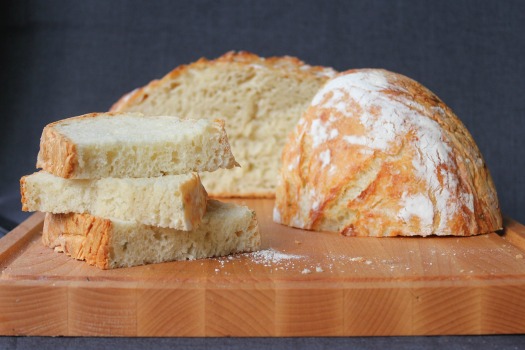
Here are a couple options for Dutch Ovens. Any heavy, lidded 5-8 quart pot (seasoned cast iron or enamel coated) would work with this recipe. Lodge has the best prices/options for dutch ovens on Amazon.
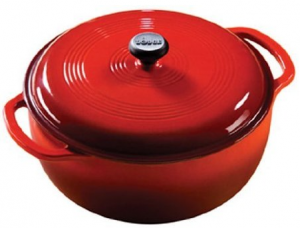
Lodge Logic Dutch Oven in Island Spice Red (6 Quart)
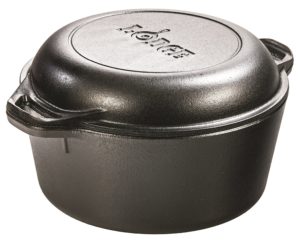
Lodge Cast Iron Double Dutch Oven (5 Quart)
If you already have a dutch oven (or find a deal on a lesser-known brand) that doesn’t have a knob rated for high temps, replace it! There are some really affordable options.
Got questions? You are in good company. Go here for the complete FAQ list.
Looking for more variations to the no-knead bread recipe? We’ve created a list with sweet and savory varieties, including the following:
- Cranberry Orange
- Four Cheese
- Sandwich Bread
- Dark Chocolate Coconut
- Tomato Basil Cheese
- Whole Wheat
Looking for more delicious bread recipes?
Find more delicious recipes on our Recipe Page!
Follow Frugal Living NW on Pinterest!
Fantastic range of boards from best recipes and tips for frugal living to gardening and budgeting help.
This post may contain affiliate links. See the disclosure policy for more information.
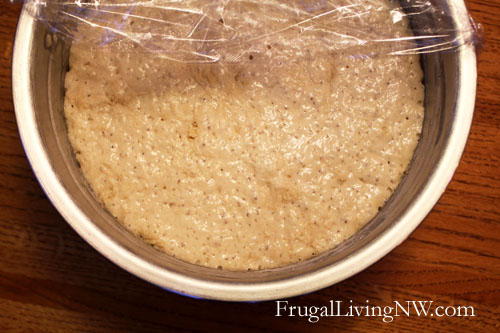
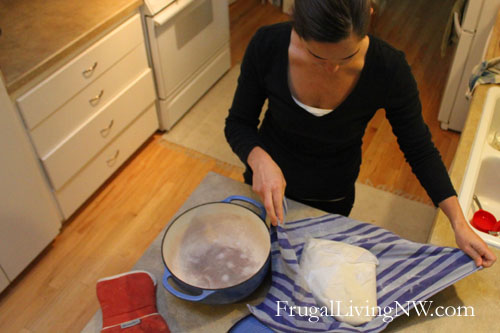
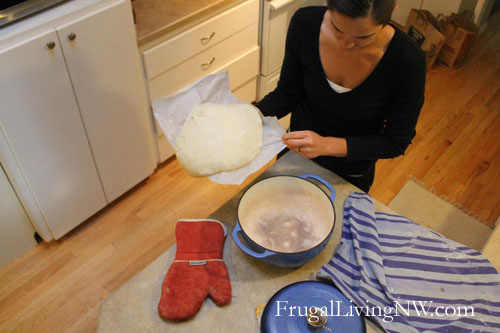

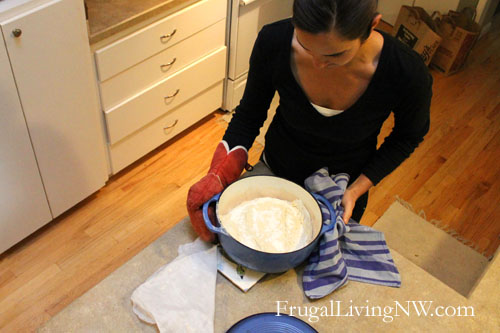


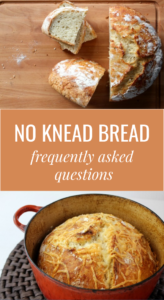
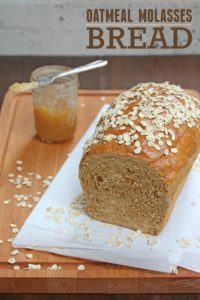
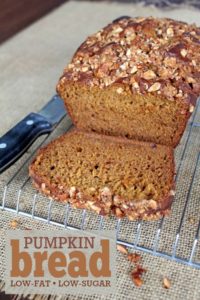
Love Jim’s bread recipe. I have many new friends since I started making artisan bread and giving it as gifts! The only thing different that I do than what you do, is that I let the dough rise on a piece of parchment paper and put paper and dough into heated cast iron pot. So much easier for me. Thanks for a GREAT informational post!
I have a very small dutch oven – 2 3/4 qt to be exact. Should I just quarter the recipe?
I’d try just cutting the recipe in half. If you’re nervous, you could start with 1/4, then go up from there…
Thank you for the picture of the first rising. I would have thought the first rising wasn’t complete without it. It doesn’t look rounded on top; that’s okay!
I didn’t oil my pot. I have a beautiful loaf of bread stuck in my pot
Run a spatula around the outside and set the pot on it’s side for 15 minutes and then rotate to the other side. It will slowly release as the steam builds underneath the bread. You might have some of the bottom stick but you’ll be able to get it out.
I baked this bread a few hours ago…some of the best ever.
Thanks for the recipe, photos and explanations. I will be making this a lot.
The recipe looks really nice but I just have a clay baker at home. Do you think it will work nonetheless? Because in a clay baker the temperature shouldn’t go up a lot higher than 200 °F either.
I use my clay baker all the time. Since the recipe makes two loaves, I make one loaf in a cast iron dutch oven the other loaf in the clay pot. I bought my clay pot years ago at a yard sale and had no idea if it would hold up to the high heat, but the loaf turned out beautiful! So I get one perfectly round loaf (dutch oven) and one oblong loaf (clay baker). I hope yours turns out as well as mine do!!!
How long do you soak your clay baker before preheating it? I just inherited it from my mother, and don’t have the instruction manual yet. What temperature do you bake it ?
I didn’t soak mine at all. I did the first time but it didn’t seem to matter after that. So, I don’t soak it. Let me know how yours turns out.
When ready to work the dough I put it on parchment paper(personally I don’t work the dough, just let it rest on the parchment for a couple of hours and it is wonderfully filled with air pockets when baked and light as a feather) when ready to bake pick up the paper and dough and drop both in the pot, no need to flip, the parchment lines the pot….no clean up
do you put flour or cornmeal on it when you put on parchment or do you just let it be?
I baked this bread this morning. I did something wrong. The bottom is awful hard. I can barely cut it with a steak knife. Any suggestions?
I have made this recipe 3 times so far. Turns out perfect every time. Even made biscuits. Yum. I have a hard time saving any for anyone else. Simple recipe but so addicting and amazing with a side of olive oil and Italian seasoning. Thanks for sharing!
How did you make biscuits? Sounds good!
I made this bread. It was really good! My picky 6 year old thought it was the best bread he’d even eaten. I was so proud of myself and it really was very easy!
Thank you, this recipe is fabulous. My shortcut is that I use the parchment paper rounds (used to line round cake pans) and it keeps me from having to flip it over into the dutch oven. I take about the size of a grapefruit of dough, (the 6-cup batch makes 2) do the folding and tucking under, put a parchment paper round on a cookie sheet, sprinkle it heavily with cornmeal, and put the tucked dough on it. I let it rise in a turned-off oven after heating it to just barely 100 degrees, maybe less. Just so it feels cozy, not hot. It rises in there until ready to bake, I take it out so that I can preheat the oven and cast iron, and when oven temp is ready I take the dough under the parchment paper with a pizza peel. Steadying the front edge of the paper, I can slip it off and lower it into the cast iron without having to turn it over.
Mixing subsequent batches into the old container without washing it will encourage a sourdough. After a while it will be slightly pungent and the recognizable sourdough smell.
This is now my favorite bread recipe. Thanks again.
What is the “old container ” that you refer to?
I tried a slow-rise pizza dough recipe and it was a disaster. I followed the recipe to the letter and the dough wouldn’t rise. I’ve been making homemade pizza for years, so I threw out the slow-rise dough (no rise, in my case) and started over with my traditional pizza dough recipe. I used the same yeast, so the problem wasn’t the yeast. Using my old recipe, the dough rose beautifully and the pizza was delicious.
Make sure you’re using quick rise or rapid rise yeast for best results. I make no knead pizza doughs a lot, and I never have a problem since I started using rapid rise yeast.
I have always been intimidated by baking bread until this recipe. It turned out perfect and delicious! There is so much of it for just two people. If I were to half the recipe, should I use half of the amount of yeast too?
So happy you finally found bread baking success with this recipe! And yes, for a smaller loaf, halve all the ingredients. Bake for 30 minutes covered and 10-15 uncovered.
I made this yesterday and I am blown away by how easy it was! Glad someone else asked about halving it, though, because there’s no way hubby and I will ever eat all of that in 3 days. Can’t wait to try the whole wheat variation, too!
I cut mine into five sections and freeze them. They thaw well and taste just as good as when they were first made!
I loved this recipe! It’s such an easy and fun way to make delicious bread, once I’ve done it for the first time I got addicted! I have translated your recipe for portuguese and posted on my blog, my friends in Brazil are loving it. Cheers!
Yay! Thanks Luiza
WOW!!!! I live with chronic pain and am trying to improve my, and my family’s, health. This was so easy to make! Everyone loves it and asked me to make more. Now I have a rosemary and parmesan loaf ready to cook.
I have been doing this kind of bread for a while now. I add a bit of rosemary, Parmesan and smoked Gouda to mine…..YUMMY! A different twist is adding orange zest and craisins is also very good too…top it off with some orange butter….delish in the morning!!!
How much rosemary and Parmesan for one recipe of the bread?
I usually just sprinkle about a tablespoon of rosemary and sprinkle the cheese so that it’s evenly distributed.
I just purchased some coconut flour at Costco, can I use this flour in this bread recipe?
No. Coconut flour has completely different properties than other flours. Recipes using coconut flour require less flour and far, far more water. Look for a bread recipe specific to coconut flour. They are pretty easy to find online–especially on paleo blogs.
Bravo!!! I just made this bread, and let me tell you…it was beyond perfect. I have had a few failed attempts at making bread so I admit I was intimidated. This recipe was easy and I expect now that I will never buy store bought bread again! Thank you so much for sharing this!
This looks yummy! Have you heard of anyone having success making this bread with a gluten free all purpose blend? There are too many comments in this thread to view them all!
I’m always on the hunt for a new bread recipe! Looking forward to trying this one and hopefully saving myself the “bread arms workout” from now on! LOL:)
I just made this bread. I love the recipe. I can made the dough after dinner and let it sit until the next nights’ dinner. I often put the pot in the oven and have the oven turn on with the timer shortly before I get home. By the time I get the rest of dinner together it is finished. I just made cinnamon raisin. I added about 1/4 cup brown sugar, 2 tsp cinnamon and some raisins. It stuck to the pan a little bit, but it is awesome! Anyone try a gluten free version of this bread?
Did you mix the sugar, raisins and cinnamon during the initial mix of the flour?
Oh my delish it looks!!
I need to start working on a gluten free trial and I’ve recipes here for gluten free bread, but I want to stay away from the potato starch and tapioca starch etc etc.. I want real bread.. I’m thinking this would be great made with oat flour. I don’t suppose anyone has yet tried it? I knew I should have bought some today when I was at the health store!
Have you tried it using the oat flour, and how well did it work? Please msg me so I don’t miss your reply?
Thanks!
I love your bread recipe! How do I go about making flavored bread? Can I simply add raisins and cinnamon (for example) to the current recipe? What about cheese and italian herbs?
Thanks!!
I’d say why not give it a shot and just try it out on a loaf, see how it goes.
Yes, you can add in all kinds of ingredients to this basic bread recipe! Check out our FAQ page for some more ideas: http://www.frugallivingnw.com/frugal-homemaking/no-knead-bread-answers-to-faqs/
My all time favorite add-in ingredients is Trader Joe’s Quattro Formaggio cheese (it’s one of their shredded cheese blends). It makes the most incredible cheese bread! Simply add a handful (1-2 cups) to the dry ingredients before adding the water. Proceed with recipe, as written!
If you use dried fruits your bread may be drier bc the fruits absorb the water. You might have to play around a little to get water content right.
G’day
love the bread – thanks- have read that bread for second rising can be put into dutch oven and into cold oven – turned on and cooking time from when cooking temperature reached and further lid removed and allowed 15 minutes to brown.
would like your opinion on these ideas
kind regards
peter
Hi, Peter! I’ve never tried that but this is a thread from the super helpful site, The Fresh Loaf, that talks specifically about that method: http://www.thefreshloaf.com/node/26049/cold-dutch-oven-proof-bread-then-bake
Hope that helps!
Has anyone tried doing this bread in a crock pot? I’ve been reading a bit about doing that, and want to find a good recipe for that so I don’t have to turn my oven on more than necessary in the summer (and hope to have my bread baking down pat before our 3rd LO arrives this spring)!!
My husband linked this website to my facebook wall. http://www.artisanbreadinfive.com/2012/05/29/crock-pot-bread-baking-fast-bread-in-a-slow-cooker
Personally I’m not interested in it, since you still have to put the bread under a broiler to get the crust browned, but hey, if you wanna try, go for it!
I have made this about 4 times in the past two weeks. It is so easy!!! My husband loves the bread toasted with his bacon and eggs. Like you, we just keep it in the pan and slice as needed. Thank you for posting and giving such great instructions.
I just baked a loaf of cinnamon raisin (adding TJ’s pumpkin pie spice and brown sugar). Wow. So rich, I can’t even take it. I’ve known of this recipe since you originally posted it; back then I bought a huge bag of Better for Bread flour, and two cast iron dutch ovens just to make it. It took getting snowed in and running out of bread to actually whip it up though, haha. We (my husband and son are nuts about it now too) made 3 loaves and a batch of rolls over the last week, and they all turned out so perfectly in their own way! Thank you for concocting this bread formula, it’s just that in a world where nothing is perfect, this REALLY is.
Thanks, HeyCupcake! We love it, too. My husband braved the snow here last weekend to go to the store just to buy a 10-lb. bag of flour. Ha! We’re hooked.
I just received a Dutch oven as a gift. Could I add sunflower and pumkin seeds or nuts to this receipe to make it healthier?
Yes! Read the comments or our FAQ post for more add-in ideas: http://www.frugallivingnw.com/frugal-homemaking/no-knead-bread-answers-to-faqs/
Can some healthy grains or different flours be added?
Love this bread it is silly easy to make, but would love to boost the nutritional value. thanks
Yes! I’ve been adding all kinds of different grains and flours (millet, barley, buckwheat, spelt, oat), with great results. Each loaf turns out a little differently, but I haven’t made a bad one yet.
never mind. I was in the wrong book. SMH! sorry
I purchased the book, and I was curious about other recipes, but couldn’t find this particular recipe. Is there another name they call it?
I used to make this quite a lot, but got out of the habit. but I did.
but I did.
Yesterday afternoon I decided to mix up a batch and found out I was short of flour. I wanted a largish loaf and spied a box of instant mashed potato flakes in the pantry. I had 4 cups of flour, and added maybe 1 and 1/2 cups of potato flakes, less than half a teaspoon of yeast, a pinch of salt and 2 cups of tepid water.
It seemed a little dry, but I’ve had dryish dough bake up fine and I just let it rise all night and baked it off this afternoon. The Best Loaf I and EVER baked of this, slightly sweet, with a moist light spongy texture and the crust was thin but crisp. Light texture but artesian and really good. I will make this again in a few days, after I restock my flour supply. Super good and the loaf was really lovely in appearance, I almost hated cutting into it.
Great tip, Kitty, thanks! My mom used to make bread dough using the water from cooking potatoes. It made delicious, soft bread. Must be something about the starch?
Just took this out of the oven. My oh my…it looks and smells so good! I was afraid that it might not turn out as I used the 6 cups of flour recipe, but only have a 5 quart dutch oven. Turned out great though. Still waiting for the crackling to stop so we can eat it. Thanks so much for such an easy, yet wonderful bread recipe. This is definitely going to be one that I will be making quite often as we love Artisan style bread.
I just finished making the dough and realized I would be baking the bread around 2 AM. Is there a way I can freeze the dough and bake it in the morning?
This dough is really flexible/forgiving. If you need to bake it under the initial 12 hour rise time, you should be fine. If you need to bump it past the 18 hour time, just stick the dough some place cooler in your house until you bake it. I wouldn’t freeze the dough.
Then just make sure it has the 2 hour final rise, and you’ll be good to go!
Thank you very much for the recipe! I saw it on Pinterest, and was excited to try it. I used King Aurthur bread flour, but am curious how the Meijer brand or a less expensive brand of bread flour would hold up because I intend to make this at least a couple to a few times a month! I did need to add a bit more water because of the lack of humidity in our house (A very cold January in Michigan this year). My husband and I kept going back for more once it was “mostly” cooled. We had a hard time waiting. He travels to Europe for work and has had his fair share of fresh bakery breads. I would eat this with jam, turkey and cheese sandwiches, anything with egg on top, with soup…it’s just so good. Thanks again!
I’m happy you had such great success with this recipe/method! My husband and I have no self-control around a loaf of fresh-baked bread either…
And yes, a generic brand bread flour would work just fine for this recipe. I prefer Bob’s Red Mill unbleached white flour, but I use other brands, like Gold Medal, with good results!
Thanks so much for sharing this recipe! I love being able to have some wiggle room for letting the bread rise. Overnight makes it so convenient. Also, it’s so easy to use in my dutch oven. My one tip would be to purchase the Lodge cast iron model L8DD3 with Skillet Cover. This one has no handle on top so you can use the lid as a skillet. It is amazing for cooking tortillas, btw! And frugal to have “two pots” in one.
http://www.amazon.com/Lodge-L8DD3-Casserole-Skillet-5-Quart/dp/B000LEXR0K/ref=sr_1_3?ie=UTF8&qid=1391199250&sr=8-3&keywords=lodge+dutch+oven+5+quart
I haven’t made this bread in two years, but I recall a friend convinced me that placing the cotton cloth on the bread as it is cooling will noticeably improve the bread. But I can’t recall exactly what the improvement was, just that I tried covering the bread and it did seem even better. I think it made the crust less hard by keeping the moisture in. Has anyone tried covering the bread, and what difference did it make?
Covering the bread with a cloth traps some moisture and softens the crust. You usually want Artisan bread to have a crunchy crust so I wouldn’t cover it myself.
Can you refrigerate this dough? I came across a recipe in the Oregonian Food Day where they had a no knead recipe for artisian bread that you kept in a bowl in your fridge (for up to 14 days). It made about 4-1 lb loaves (I think!). I tried it once with ok results but I loved that I had the dough done ahead of time and it was so easy to cut off a blob of dough, put it on the counter to “rise” and then bake later.
That recipe sounds like Artisan Bread in 5-Minutes a Day. I featured that recipe in this post: http://www.frugallivingnw.com/frugal-homemaking/making-artisan-yeast-bread-from-scratch/ I have never tried refrigerating this dough, as it uses less yeast and needs a longer rise. If you tried it, it would probably need to happen after that initial long rise. Now I’m curious. I’ll report back if I try it!
I’ve been making Lahey’s No-Knead Bread for many years, but never doubled the recipe until today. Beautiful! It’s crackling as it cools and I can hardly wait to slice it. Thanks for the suggestion!
Re: The dough sticking to the parchment: I use a tip Cook’s Illustrated published when they revamped the recipe in 2008. Spray the parchment with non-stick spray, and put it in a fry pan. After you briefly knead the dough and form it into a ball, place it seam-side down onto the parchment, lightly spray and/or flour the top of the loaf and cover with plastic wrap and a towel. When it’s ready to go into the oven, remove the plastic and towel, slash the loaf and use the parchment as a sling to lift the risen dough into the dutch oven. The parchment goes into the pot under the bread, there is no flipping involved, and stickiness, to the paper or the pot, is not an issue. The parchment comes right off after baking and doesn’t affect browning or shape at all. It’s worked well for me for 6 years, so perhaps it will be useful to someone else.
It helped so much!! Thank you!!